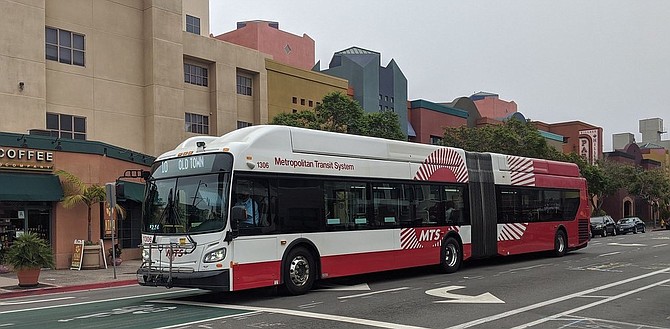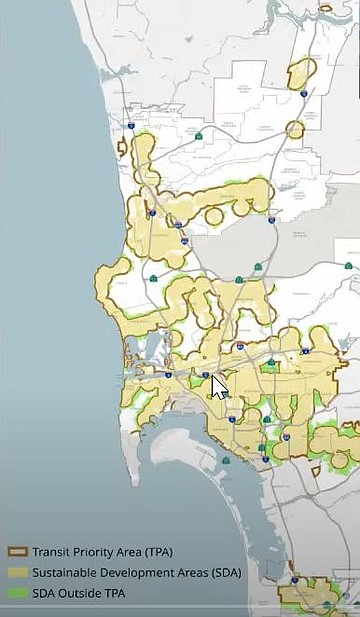 Facebook
Facebook
 X
X
 Instagram
Instagram
 TikTok
TikTok
 Youtube
Youtube

Planners last week voted unanimously to recommend the city council approve most, but not all, of the changes to the 2022 land development code update. A few still had rough edges - especially the one that would reinvent transit priority areas.
Where these growth-worthy areas fall matters to a diverse group of neighbors, realtors, developers, and advocates for climate action, mobility and housing. And for once, they all agreed.
"There is so much opposition from a lot of really strange bedfellows we don't normally see in lockstep opposing something," said commissioner Boomhower, who made the motion to hold it back until December 8 for further evaluation.
No one seemed to know if it would increase or decrease housing.
Transit priority areas are defined as falling within one-half mile of an existing or planned major transit stop. The planning commission's proposal would replace them with “sustainable development areas" involving the same transit stops, but extending further, opening new areas to housing.

According to their research, the old half-mile access to transit as the crow flies is a crude measure. Using new data, they came up with mobility zones that would stretch it out to a 1 or 3/4 mile walkshed.
Sustainable Development Areas account for canyons, freeways and other natural barriers, allowing more housing opportunities near transit, they say. Also, city-specific incentive programs near transit will be continually expanded.
The changes will remove undevelopable land, parks and open space, as well as areas having low density, industrial uses and limited accessibility. Complete communities and the ADA bonus program were not included in the adequate sites inventory, staff said.
"It's got some phenomenal, game-changing potential," Boomhower said.
Critics also saw the potential for less housing and fewer jobs near transit along with the remapping of TPAs into new, and possibly smaller, geographic areas.
"The change would reduce the amount of developable acreage qualifying for what is presently called a TPA," said Melanie Cohn, director of regional policy and government affairs at Biocom California.
"We're especially concerned about this coming on the heels of the Blueline Trolley extension to UCSD and our life science hub, the largest transit investment in the region's history," she said.
"It could also impact the university plan update happening now, reducing the number of homes and jobs."
Climate Action Plan policy advocate Madison Coleman shared the same concern about shrinking developable acreage.
"Across the region there are a limited number of infill areas that have the opportunity to reduce vehicle miles," she said. "Few jurisdictions have as many opportunities to reduce driving through infill development as the city of San Diego."
She criticized the proposal for relying on walking alone to define the mobility zone, when people use bikes, scooters, and other modes.
Jessie O'Sullivan, policy coordinator for Circulate SD, said the changes could reduce the capacity to build homes on many city parcels. "With the housing shortage, we shouldn't be downzoning anywhere," he said.
"Until today no analysis has been made public as to whether this change would increase or decrease capacity for homes. It's still not clear to me."
Planning staff said the sustainable development area is meant to be dynamic. As more trails and bike paths come online, its boundaries will grow, bringing more areas within easy reach of transit.


Planners last week voted unanimously to recommend the city council approve most, but not all, of the changes to the 2022 land development code update. A few still had rough edges - especially the one that would reinvent transit priority areas.
Where these growth-worthy areas fall matters to a diverse group of neighbors, realtors, developers, and advocates for climate action, mobility and housing. And for once, they all agreed.
"There is so much opposition from a lot of really strange bedfellows we don't normally see in lockstep opposing something," said commissioner Boomhower, who made the motion to hold it back until December 8 for further evaluation.
No one seemed to know if it would increase or decrease housing.
Transit priority areas are defined as falling within one-half mile of an existing or planned major transit stop. The planning commission's proposal would replace them with “sustainable development areas" involving the same transit stops, but extending further, opening new areas to housing.

According to their research, the old half-mile access to transit as the crow flies is a crude measure. Using new data, they came up with mobility zones that would stretch it out to a 1 or 3/4 mile walkshed.
Sustainable Development Areas account for canyons, freeways and other natural barriers, allowing more housing opportunities near transit, they say. Also, city-specific incentive programs near transit will be continually expanded.
The changes will remove undevelopable land, parks and open space, as well as areas having low density, industrial uses and limited accessibility. Complete communities and the ADA bonus program were not included in the adequate sites inventory, staff said.
"It's got some phenomenal, game-changing potential," Boomhower said.
Critics also saw the potential for less housing and fewer jobs near transit along with the remapping of TPAs into new, and possibly smaller, geographic areas.
"The change would reduce the amount of developable acreage qualifying for what is presently called a TPA," said Melanie Cohn, director of regional policy and government affairs at Biocom California.
"We're especially concerned about this coming on the heels of the Blueline Trolley extension to UCSD and our life science hub, the largest transit investment in the region's history," she said.
"It could also impact the university plan update happening now, reducing the number of homes and jobs."
Climate Action Plan policy advocate Madison Coleman shared the same concern about shrinking developable acreage.
"Across the region there are a limited number of infill areas that have the opportunity to reduce vehicle miles," she said. "Few jurisdictions have as many opportunities to reduce driving through infill development as the city of San Diego."
She criticized the proposal for relying on walking alone to define the mobility zone, when people use bikes, scooters, and other modes.
Jessie O'Sullivan, policy coordinator for Circulate SD, said the changes could reduce the capacity to build homes on many city parcels. "With the housing shortage, we shouldn't be downzoning anywhere," he said.
"Until today no analysis has been made public as to whether this change would increase or decrease capacity for homes. It's still not clear to me."
Planning staff said the sustainable development area is meant to be dynamic. As more trails and bike paths come online, its boundaries will grow, bringing more areas within easy reach of transit.
Comments